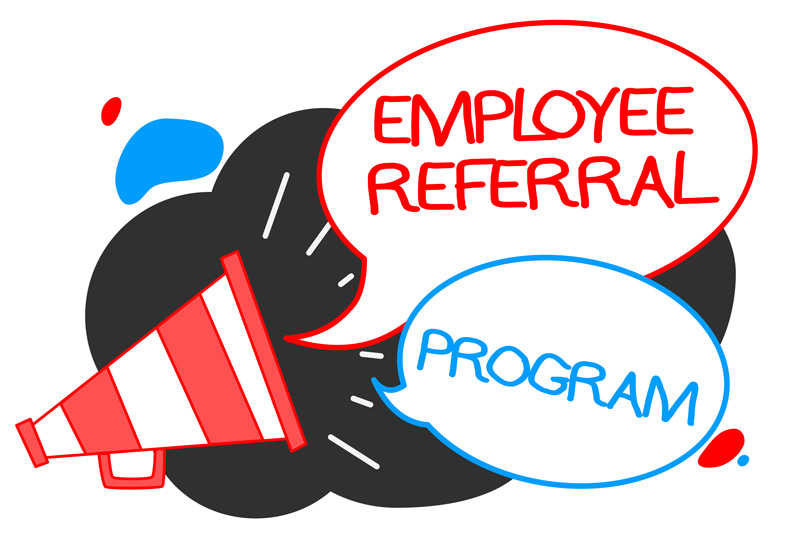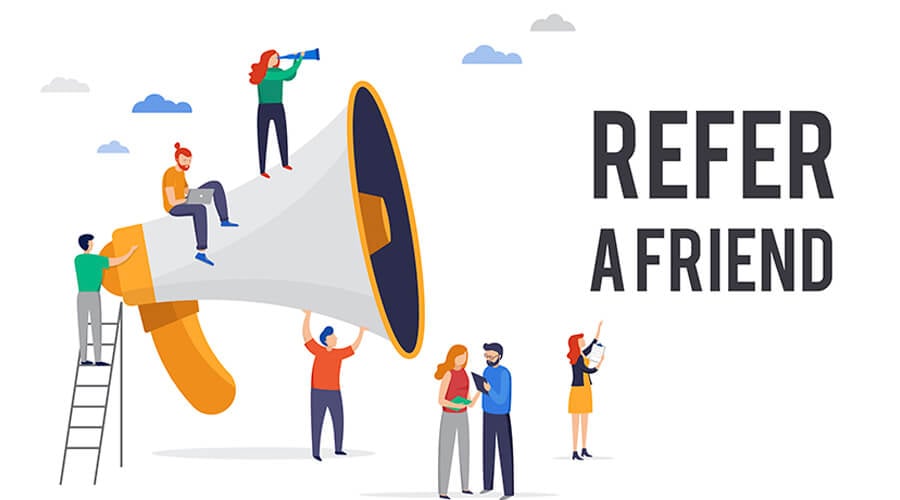Do you wonder why employee referral programs are becoming bigger and bigger with each passing day? Research from Deloitte found that just over half of organizations cite employee referrals as their number one source of high-quality candidates.

In this blog post, I will be covering aspects of Referral Hiring specifically in the field of sales and how it can bring down sales attrition rate in any organization magnanimously. You'll realize how the solution was right in front of you the whole time!
- Introduction
- What are Employee Referrals?
- Why Employee Referrals? (Benefits & Advantages)
- Referral Bonus
- Challenges to Hiring Sales Employees
- How to Implement Referral Hiring in Your Organization
- Conclusion

What are Employee Referrals?
Employee referral, referral hiring, or ERP is an in-house system or mechanism built for finding and hiring candidates for vacant roles and functions in the organization. ERPs incentivize employees to submit personal referrals from their social and professional networks who may qualify for open positions in the organization.
Incentives and rewards may include monetary bonuses and non-monetary prizes such as vacations, concert tickets, et al.
Companies are constantly seeking effective sources to recruit talent in a time characterized by talent shortage and demographic changes. Businesses are constantly on the look-out to find the most effective way to hire the best talent in the market and would do anything to find the most successful way to solve their problem. Small businesses especially find themselves searching for cost-effective sources of hiring the right candidates.
Hence, more organizations are investing in ERPs to hire new talent, as it’s no secret that employee referrals lead to great hires. Now more than ever, TA professionals are investing in mapping a referral program suiting their organization in a way that will generate more qualified employee referred candidates for their job openings.
Of all departments within an organization, sales seems the most apt for this approach.

Why?
Because good sales people likely know other good sales people because of their field and work type, and being financially motivated, they have an additional incentive to help grow the sales teams. Which is why it becomes essential to implement ERPs for sales teams.
Sales teams across industries face the same issue - retention/poaching of best performers by competitors. ERPs are maybe the best solution to this issue for the various benefits and advantages it offers, that are listed below:

1. Better retention levels
46% average retention rate as compared to 33% with the help of career sites only.
Why is that? The candidates that are referred are almost always informed about the ongoings of a company through the employee who is already working there. This information usually the HR also cannot know and/or convey to potential employees. Hence, referral hiring automatically results in higher retention and higher chances of finding culturally fit candidates.
2. Better cultural fits
A referee always tells the referred candidate or is asked about the work culture and work space dynamics which they understand much better than the HR, as discussed earlier. This ensures that only the people who know the culture and are fine with it, will be going ahead with the application to fill the vacancy in that organization. This helps organizations onboard more and more culturally fit employees, leading to higher retention.
A successful employee referral program can help achieve this goal as your employees are in the best position to evaluate the suitability of a referral to fit within your company.
3. Reduced time to hire
Referred candidates tend to start their jobs sooner than other regular hires: candidates from career sites start after 55 days; those found on job boards start after 39 days; and employee referrals start after 29 days.
Since the connection is already established with a potential candidate through the referee, the rest of the hiring process becomes easy and less time consuming. Majority of the hiring process lag occurs due to the lack of pipeline and talent availability when a requirement arises. With the cultural fitment and qualification test out of the picture, the rest of the hiring process becomes a breeze.
Also, since referred candidates mostly join through an employee that they already know, they tend to join sooner as people don’t want to jeopardize their relations with the referee who is helping them with a job opportunity.
Here is an eBook that will guide you to have a Fast and Friendly Hiring process that your candidates will LOVE.
4. Better quality candidates
Employees end up referring candidates that are their school or college batchmates, or ex-colleagues. This means there is an already established quality of the referred candidate along with a POC. Hence, so the chances of them being selected are higher. Since a person from the same institution is already working in the organization, the chances of the referred candidates being selected is higher, henceforth maintaining the quality of the employees being hired in the organization.
5. Higher applicant conversion rate
The software company Careerify found that referred employees are 23% less likely to quit than other hires.
Since referred candidates are aware they are being considered in an organisation and have real chances of being selected, the conversion rate of referred candidates is much higher than candidates that have minimal contact with the said organization.

6. Cost-effective
A Glassdoor survey estimates the average cost of hire in the US at $4,000. This figure covers external recruiting costs, pre-hire assessments, sourcing, extensive background checks, and potentially the use of agencies.
A successful EPR can help to reduce these costs drastically. Referral programs are much cheaper to the organization when compared to finding talent in the market from scratch. Ensuring a pool of pre-qualified candidates also reduces hiring costs. ERPs significantly reduce recruitment costs, with a study finding that businesses can save $3000 or more per hire just by using referrals.
ERP-sourced candidates deliver the highest ROI compared to other methods - they produce 25% more profit for their companies than new hires sourced via other means.
7. Encourages greater employment brand
If a person talks to you about an organization that they have nothing to do with and tells you good/bad things about them, would their words have more leverage on your judgement of the organization or would you believe an employee of that same organization?
A 2015 study found that 75 percent of job seekers consider the employer’s brand and reputation before even applying for a position. With the existence of platforms like Glassdoor, where employees and former employees are all given a space to express an opinion, it’s important that you make an active effort to engage them.
Employee referral programs encourage current employees to really think about the positives of working in the organization, and then spread the word among their network. Even if the employee doesn’t have a specific person in mind, the right incentive might lead to social media posts and other forms of large scale sharing.
With these stats in place, there is no reason a company should not take advantage of their employees’ networks. Quite frankly, there are many advantages for employees as well when hiring someone out of their trusted network. Who wouldn’t like to build their own team?

Referral Bonus
Once your employee referral program and policies are in place, you may want to consider planning for an employee referral bonus. Offering a mix of monetary and non-monetary incentives for successful referrals is one of the best forms of reward for employees. Bonuses include things like a gift card, employee trip, or extra paid vacation.
Few excellent examples of referral bonuses that have been proved to be resourceful for the employees as well as the organization are:
- Salesforce engages employees in healthy competition.
- Google offers a trip to Hawaii to successful referrers.
- DigitalOcean gives prize money to charity.
- Cognizant offers cash prizes, paid vacation, cars, and double referral money for closing niche roles & skills.
|
Some of the statistics by LinkedIn on referral hiring:
|
Challenges to Hiring Sales Employees
Some of the key characteristics that are absolutely essential for any sales person are resourcefulness, smartness, adaptability, persistence, competitiveness, coachability, and focused on their Work.
Roughly 50% of college graduates will work in sales positions, and 55% of salespeople do not have the necessary skills to succeed. (Source)
A lot of the times organizations end up hiring and firing due to multiple reasons, which is why it becomes important to check the following before hiring for a sales role:
- Lack of industry knowledge (When candidates have been taken from a completely different industry)
- Cultural misfit
- Fraudulent candidates
- Not compromising on talent due to budget constraint
In sales, the annual turnover is roughly 25% to 30%. With this fact, you know you’re going to end up hiring someone who will leave or get fired soon. Which is why you need to hold on to top talent that you hire and make them feel appreciated. As already discussed, retaining sales employees is a major challenge in any organization with no proper solution in place. Great salesmen are easily poached by competitors offering them a higher package.
.png?width=1366&name=Screenshot%20(28).png)
To make informed sales hiring is a challenge which Talview has understood and addressed with the help of Salesforce. Imagine being able to hire the right salesperson before you feel the pain of too many sales leads and not enough sellers ramped up to engage your future customers. Talview’s predictive hiring application for Salesforce enables organizations to hire the right person, at the right time, leveraging the data they are already collecting in their Salesforce CRM. The app utilizes a variety of data points in Salesforce CRM, including pipeline growth and sales executive ramp up time, to provide sales managers with AI/ML powered predictive hiring recommendations. Sales managers receive notifications within Salesforce on when to hire new account managers. Once a job recommendation is approved, a workflow is kicked off enabling other sellers in the organization to refer job candidates from within Salesforce. The Talview Instahiring platform then uses AI and ML to score applicants resumes, automatically schedule AI/ML proctored applicant assessments, and then utilize NLP to automatically score candidates using Talview Behavioral Insights & identify the right candidate profiles for high performing account executives. Talview’s automation of these top of funnel screening of candidates frees up your recruiter’s time to spend on high value, personal engagement, with candidates.
This integration also offers referral hiring feature, where anyone can refer friends, colleagues, college batch mates, etc for an open position.

How to Implement Referral Hiring in Your Organization
These days mostly all companies use some sort of ATSs. When using an ATS, you’ll probably find great candidates who have applied to open positions in your organization, but they never come through. Even if they do, you never know if they will qualify.
The solution to this is usually to automatically use data from your ATS in your referral process.
Let’s say you receive an application from some candidates. By using your connections and ATS data, you can automatically filter out who knows who. This allows you to suggest the right people to your connections, who can then vouch for a candidate’s skills and background experience. This option narrows down the candidate pool without leaving you with a lot of work.
Conclusion
Whether you are starting to build an employee referral program or have been running one for a while, getting the results you expect isn’t that easy. You may use the best HR technologies in the market but automation only helps make manual processes easy and effortless.
Valuing people and employees is the first step in strengthening your employer brand. If your brand sticks to its values, your employees will happily and willingly submit candidate referrals to a company they are proud of.






Leave a Reply